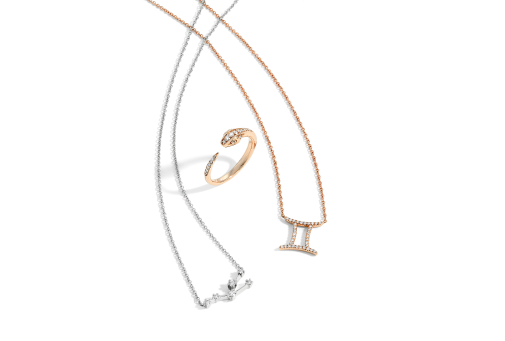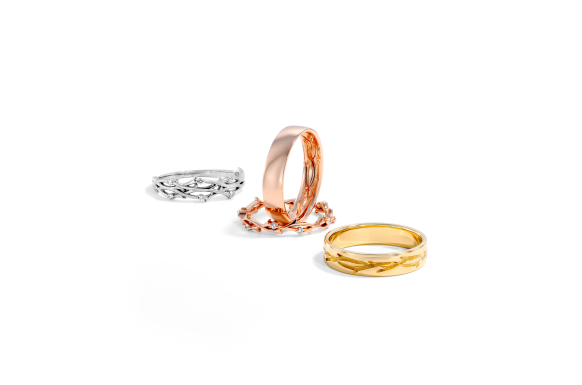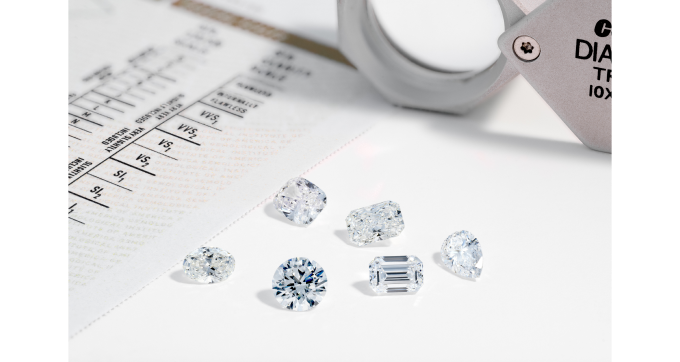H Colored Diamonds: Hitting the Sweet Spot Between Affluence and Affordability
You may have thought that all diamonds were twinkling white. But in reality a completely clear diamond is an incredibly rare find.
In nature, almost all diamonds have a subtle yellow tint. Each stone is evaluated and assigned a letter from D (colorless) to Z (a light yellow). But most stores only accept colorless (D, E and F) and near-colorless (G, H and I).
H colored diamonds are second in line in the near-colorless range. But are they lustrous enough to set in stone? Let’s unpack it.
The Truth Behind H Colored Diamonds
H colored diamonds fit into the “near colorless” category of the GIA’s diamond color scale. This means that they have a slight tint of yellow. But just how slight is this tint? And can we see it with the naked eye?
In order to grade a diamond, it is assessed under bright lighting and magnification by a diamond expert. These are the conditions necessary to detect the slight tint in an H colored diamond. And it is almost impossible for anyone else to differentiate an H colored diamond from their colorless counterparts.
Are H Colored Diamonds Good Enough for Engagement Rings?
H colored diamonds are the industry’s best kept secret. They appear colorless to the naked eye. Yet they are valued at significantly lower prices.
If an H color diamond is well cut, it is almost impossible to detect hints of color. And even if you have an extremely sensitive eye, the difference between an H colored diamond and colorless diamond is incredibly subtle. If you view the diamond from the side, the slight hue becomes slightly more visible. But you still only come across a minute amount of color.
While you may not be able to notice the difference in color, your bank balance certainly will. Near-colorless diamonds are sold for a fraction of the price of colorless ones. And this makes H colored diamonds among the most popular picks for engagement rings.
Is an H Colored Diamond Right for You?
H colored diamonds are a popular choice when it comes to committing to that special someone. But that doesn’t necessarily mean that the near-colorless stone is right for you. Let’s take a look at a few factors that may contribute to your decision.
The Cut of Your Diamond
The cut of your diamond will ultimately affect how much of an H colored diamond’s tint is exposed.
Brilliant cuts do a brilliant (pun intended) job of radiating light. And this excessive scintillation generally conceals any slight color deviations. As a result, round, oval and pear cut effortlessly complement H colored diamonds. While emerald cuts also do a remarkable job of disguising a slight hue with their step cut faceting.
On the other hand, asscher cuts are relatively deep and tend to reveal more of the diamond’s color. And the squarish nature of a princess cut is also more exposing. If these are the shapes you’re working around, you should probably consider a colorless diamond.
Your Ring Setting
Well-cut diamonds H colored diamonds typically appear totally white in any diamond setting. And it shouldn’t matter whether your setting is gold, silver or platinum. However, if you’re working with a poorly cut, H colored diamond, you can use specific settings to mask the yellow tint.
Yellow gold or rose gold are excellent metals to pair with yellowish hues. Both of these settings will contrast the poorly cut H colored diamond. And they will create the illusion that the stone is whiter than it is.
The Clarity of Your Diamond
Savvy spending and sumptuous stones don’t have to be mutually exclusive. And there’s no shame in trying to maximize your diamond’s aesthetics without paying for unnoticeably high quality. And in order to hit the nail on the head, you’ll want to take the clarity of your diamond into account.
The most popular clarity grades for H color diamonds are VS1 and VS2. And while VS1 grades are exclusively clean to the naked eye. VS2 grades reveal barely noticeable imperfections. At the end of the day, both clarity grades are appropriate for H colored diamonds.. Although we’d be weary to go any lower than this.
G Colored Diamonds VS H Colored Diamonds
G colored stones are highly praised with persuasive marketing. And the diamond industry is capitalizing on our fear. In recent years, most companies have significantly raised the price of G colored diamonds, while the price of H colored stones has remained the same.
An H colored diamond is only one step down from a G colored rating in the near-colorless range. So if it’s difficult to distinguish an H colored diamond from a colorless diamond—you can only imagine how hard it is to tell the difference between an H colored diamond and G colored diamond. And if you can’t notice it, does it really matter?
All in all, we’d recommend getting an H colored diamond. And if you have more to spend, put it towards a better cut, clarity or size.
H Colored Diamonds VS I Colored Diamonds
Now this is where we draw the line. While it’s incredibly difficult to distinguish an H colored diamond from a G colored diamond—we can’t say the same for I colored diamonds. The yellow tints are a lot more obvious in I color diamonds. And if you’re after that tantalizing, transparent effect, you’ll have a tough job disguising the less-subtle hue.
Are H Colored Diamonds Expensive?
You know that elusive, value sweet spot? This color-grading nails it. The H colored diamond maximizes the diamond’s aesthetics without maximizing on price. And although they are almost identical to colorless diamond, the price difference is huge
For the same cut, clarity and size—you can pay up to $1, 000 dollars less for an H colored diamond than a F colored diamond. And the price difference between H colored stones and E or D colored stones, only gets steeper.
So if you’re looking for more bang for your buck without compromising on appearance—this is the color-grading for you.
Exceptions to the Rule
As a general rule, H colored diamonds are the best value for money. But every rule comes with exceptions. And our affinity for this color-grading has its limits. We wouldn’t recommend H colored diamonds for:
- Asscher cuts and princess cuts.
- Extremely large diamonds (bigger than 3 carats.)
- A very tight budget.
- A poorly cut diamond.
Top Tips for to Make H Colored Diamonds Appear Whiter
If you’re dating a geologist or an artist and you’re worried that they’ll pick up on the impossibly slight hue of an H color diamond—here are some tricks to make your stone appear whiter than it is.
- Contrast the diamond with a yellow gold or rose gold setting.
- Contrast the diamond with low grade (J) diamonds on either side.
- Spend more on a higher quality cut.






